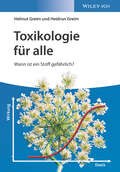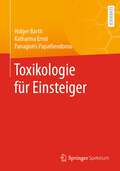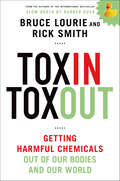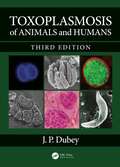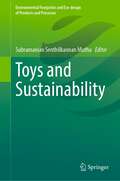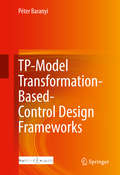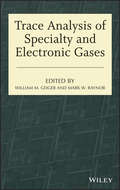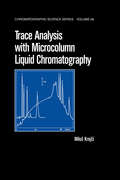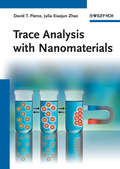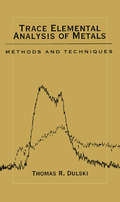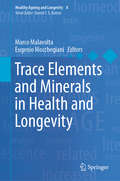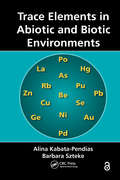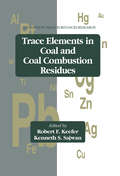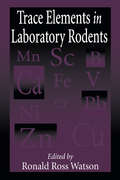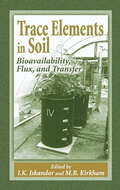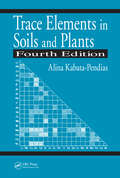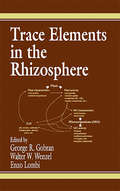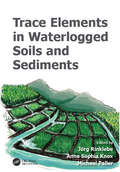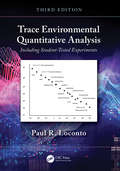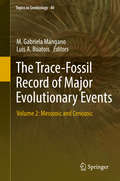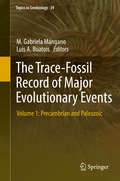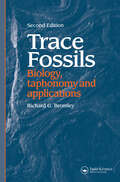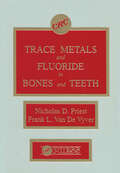- Table View
- List View
Toxikologie für alle: Wann ist ein Stoff gefährlich?
by Helmut Greim Heidrun GreimWas man über Giftstoffe, deren Wirkung und Bewertung wissen muss: Zwei erfahrene Toxikologen erklären allgemeinverständlich, wann ein Stoff zum Schadstoff wird. Der Schwerpunkt liegt dabei auf den allgemeinen Grundlagen einer toxikologischen Untersuchung und Bewertung von Schadstoffen, sowie den daraus abgleiteten Handlungsempfehlungen. Anhand bekannter Beispiele aus den letzten Jahren, u. a. des Unkrautvernichters Glyphosat oder des Insektizids Fipronil, die beide in Nahrungsmitteln nachgewiesen wurden, wird erläutert, wie konkrete Gesundheitsgefährdungen anhand toxikologischer Daten und Verfahren ermittelt und welche Maßnahmen zum Schutz der Gesundheit daraus abgeleitet werden. Die Anwendung der toxikologischen Verfahren für die Bewertung von Gesundheitsrisiken wird anhand von Beispielen aus dem Alltag anschaulich dargestellt, von Lebensmitteln über Kosmetika bis hin zu Arzneimitteln und Alltagsprodukten. Ein kompakter, aber fundierter Einstieg in ein wichtiges und oft kontrovers diskutiertes Thema - für alle, die Toxine und deren Wirkungen auf Mensch und Umwelt verstehen wollen.
Toxikologie für Einsteiger
by Holger Barth Katharina Ernst Panagiotis PapatheodorouIn diesem kurzen Lehrbuch werden grundlegende wissenschaftliche und klinische Aspekte der Toxikologie dargestellt und ihre wichtigsten Inhalte, Ziele und Aufgaben beschrieben. Das Buch richtet sich an Studierende biowissenschaftlicher und chemischer Bachelor- und Masterstudiengänge, die Toxikologie als medizinisches Wahlfach belegen. Zu Beginn werden wichtige toxikologische Fachbegriffe definiert, um den Einstieg zu erleichtern. Es wird beschrieben was ein „Gift“ ausmacht und wie Giftstoffe in den menschlichen Körper gelangen können. Akute Vergiftungen, ihre Ursachen und die wichtigsten Maßnahmen für ihre Therapie werden im Einzelnen vorgestellt. Der Großteil des Lehrbuches beschreibt die Wirkung ausgewählter, medizinisch relevanter Giftstoffe aus Natur und Umwelt, häuslicher Umgebung und dem Arbeitsplatz wie Toxine aus Tieren, Pflanzen, Pilzen und Bakterien, Giftgase, Stäube, Metalle, Pestizide, Lösungsmittel und Alkohol. Am Ende werden die grundlegenden Prinzipien der chemischen Kanzerogenese zusammengefasst und die krebsauslösende Wirkung einiger toxikologisch wichtiger Substanzen exemplarisch vorgestellt sowie rechtliche Grundlagen im Umgang mit Giftstoffen zusammengefasst.
Toxikologie und Rechtskunde: Kompetenzfördernde Wissensvermittlung der Gefahrstoffkunde
by Peter-Jürgen KramerAuf dieses Buch haben Lehrende und Studierende in Chemie, Biochemie, aber auch in anderen chemienahen Fachgebieten lange gewartet. Dieses Buch ist ideal für Lehrende und Studierende im Fach Gefahrstoffkunde an Hochschulen und Universitäten, denn es bietet ihnen das Rüstzeug für die Gestaltung erfolgreicher Lehrveranstaltungen bzw. für einen erfolgreichen Abschluss in diesem Studienfach.Die Besorgnis, dass chemische Stoffe eine Gefährdung für die Gesundheit der Menschen und ihrer Umwelt darstellen können, ist begründet. Chemische Stoffe können schädigen, und daher gefährlich sein. Die zahlreichen Berichte von dramatischen Chemieunfällen und Umweltkatastrophen wie die von Seveso (1976) und Basel (1986) sind präsent und prägen das Bewusstsein in Gesellschaft und Politik. Nach den Gründen, warum die Geschichten katastrophaler Chemieunfälle in der Vergangenheit liegen und in heutiger Zeit in der europäischen Welt nicht mehr vorgekommen sind, wird jedoch selten gefragt.Dabei ist die Antwort auf diese Frage einfach: Die in der Chemie arbeitenden Menschen und die Behörden haben gelernt, mit den Gefährdungen und Risiken, die von chemischen Stoffen ausgehen, kompetent umzugehen. Die angewandte Wissenschaft, die diese Kompetenz vermitteln muss, ist die Gefahrstoffkunde, eine Kombination aus Toxikologie und Rechtskunde, im Studium ein Pflichtfach für jede Chemikerin und jeden Chemiker, aber auch für weitere Studiengänge, bei denen chemische Stoffe eine wichtige Rolle spielen. Der mit dem erfolgreichen Abschluss im Fach Gefahrstoffkunde verbundene amtliche Sachkundenachweis muss auch nach dem Studium regelmäßig aktualisiert werden.
Toxin Toxout: Getting Harmful Chemicals Out of Our Bodies and Our World
by Bruce Lourie Rick SmithHow do I get this stuff out of me?Bruce Lourie and Rick Smith, two of North America's environmental leaders, have been asked this question on an almost daily basis since the publication of their runaway international bestseller, Slow Death by Rubber Duck: How the Toxic Chemistry of Everyday Life Affects our Health. Their answer? It's not as simple as we'd like, and it's not as easy as we'd hope. But it's too important to ignore. In Toxin Toxout, Lourie and Smith give practical and often surprising advice for removing toxic chemicals from our bodies and homes. There are over 80,000 synthetic chemicals in commerce today, and the authors use their outrageous experiments (they and their brave volunteers are the guinea pigs) to prove how easily our bodies absorb these chemicals. With trademark humor, they give us the good news about what is in our control, the steps we can take to help our bodies remove our toxic burden -- and what we can do to avoid it in the first place. Furthermore, Lourie and Smith investigate the truth behind organic foods, which detox methods actually work, if indoor air quality is improving, how we dispose of waste (where do those chemicals go?), and the ins and outs of a greener economy. The result is nothing short of a prescription for a healthier life.
Toxoplasmosis of Animals and Humans
by J. P. DubeyThis is the only book to cover toxoplasmosis of animals and humans thoroughly in one single source. Found worldwide from Alaska to Australasia, Toxoplasma gondii is the cause of one of the most common parasitic infections in humans, livestock, companion animals, and wildlife, and is included on the list of potential bioterrorism microbes. Furthermore, T. gondii has been and continues to be used extensively as a model for the cell biology of apicomplexan parasites. In the decade since the second edition of this book was published, there has been an explosion of knowledge concerning the parasite Toxoplasma gondii and toxoplasmosis. This update provides unique information on all known host types for this parasite, with an additional chapter on history, substantial updates throughout, and a detailed focus on the biology of the parasite in Chapter 2. The third edition is compiled by author JP Dubey, an authority on T. gondii who has worked with virtually all hosts of the protozoan during the last 55 years, including humans, all livestock species, wildlife, and zoo animals. The book distills the voluminous and potentially confusing scientific literature, that has grown geometrically in the 30+ years since the publication of the first edition, into a comprehensive resource for all professionals, graduate students and researchers working in this field.
Toys and Sustainability (Environmental Footprints and Eco-design of Products and Processes)
by Subramanian Senthilkannan MuthuThis book presents five interesting chapters dealing with the sustainability of toys. The concept of sustainability has reached all industrial sectors these days and being practiced in almost all the sectors. One of the main sectors where sustainability has to be embedded to the core is the toy sector. Needless to enumerate the importance of sustainability in this sector especially when it comes to usage of chemicals and so on. There are various elements associated with the sustainability of toys and there is a dearth of published literature on this subject.
TP-Model Transformation-Based-Control Design Frameworks
by Péter BaranyiThis book covers new aspects and frameworks of control, design, and optimization based on the TP model transformation and its various extensions. The author outlines the three main steps of polytopic and LMI based control design: 1) development of the qLPV state-space model, 2) generation of the polytopic model; and 3) application of LMI to derive controller and observer. He goes on to describe why literature has extensively studied LMI design, but has not focused much on the second step, in part because the generation and manipulation of the polytopic form was not tractable in many cases. The author then shows how the TP model transformation facilitates this second step and hence reveals new directions, leading to powerful design procedures and the formulation of new questions. The chapters of this book, and the complex dynamical control tasks which they cover, are organized so as to present and analyze the beneficial aspect of the family of approaches (control, design, and optimization). Additionally, the book aims to convey simple TP modeling; a new convex hull manipulation based possibilities for optimization; a general framework for stability analysis; standardized modeling and system description; relaxed and universal LMI based design framework; and a gateway to time-delayed systems.
Trace Analysis of Specialty and Electronic Gases
by William M. Geiger Mark W. RaynorExplores the latest advances and applications of specialty and electronic gas analysis The semiconductor industry depends upon a broad range of instrumental techniques in order to detect and analyze impurities that may be present in specialty and electronic gases, including permanent gases, water vapor, reaction by-products, and metal species. Trace Analysis of Specialty and Electronic Gases draws together all the latest advances in analytical chemistry, providing researchers with both the theory and the operating principles of the full spectrum of instrumental techniques available for specialty and electronic gas analysis. Moreover, the book details the advantages and disadvantages of each technique, steering readers away from common pitfalls. Featuring contributions from leading analytical and industrial chemists, Trace Analysis of Specialty and Electronic Gases covers a wide range of practical industrial applications. The book begins with the historical development of gas analysis and then focuses on particular subjects or techniques such as: Metals sampling and ICP-MS analysis Improvements in FTIR spectroscopy Water vapor analysis techniques New infrared laser absorption spectroscopy approaches GC/MS, GC/AED, and GC-ICP-MS techniques Gas chromatography columns Atmospheric pressure ionization mass spectrometry Lastly, the book examines gas mixtures and standards that are critical for instrument calibration. There are also two appendices offering information on fittings and material compatibility. With its thorough review of the literature and step-by-step guidance, Trace Analysis of Specialty and Electronic Gases enables researchers to take full advantage of the latest advances in gas analysis. Although the book's focus is the semiconductor and electronics industry, analytical chemists in other industries facing challenges with such issues as detection selectivity and sensitivity, matrix gas interference, and materials compatibility will also discover plenty of useful analytical approaches and techniques.
Trace Analysis with Microcolumn Liquid Chromatography
by Milos KrejciThis book provides a detailed description of technical elements of a microbore column liquid chromatograph suitable for use in trace analysis. It presents examples of analyses, especially from the spheres of biochemistry, pharmacology, and environmental analytical chemistry.
Trace Analysis with Nanomaterials
by David T. Pierce Julia Xiaojun ZhaoPresenting a wide variety of methods, this book provides a comprehensive overview of the current state -- ranging from bioanalysis to electrochemical sensing, forensics and chemistry, while also covering the toxicity aspects of nanomaterials to humans and the environment. Edited by rising stars in the field, the first section on biological analysis includes an investigation of nanoparticles and micro- and nanofluidic systems, while the second, environmental analysis, looks at the detection, monitoring, and sensing of explosives as well as pollutants, among other topics. The final part covers such advanced methods as the synthesis and characterization of gold nanorods. For analytical chemists, materials scientists, chemists working in trace analysis, and spectroscopists.
Trace Elemental Analysis of Metals: Methods and Techniques
by Thomas R. DulskiThis work details minor, trace and ultratrace methods; addresses the essential stages that precede measurement; and highlights the measurement systems most likey to be used by the pragmatic analyst. It features key material on inclusion and phase isolation. The book is designed to provide useful maps and signposts for metals analysts who must verify that stringent trace level compositional specifications have been met.
Trace Elements and Minerals in Health and Longevity (Healthy Ageing and Longevity #8)
by Marco Malavolta Eugenio MocchegianiThis book describes the role of trace elements in health and longevity, pursuing a biogerontological approach. It offers essential information on the impact of trace elements on molecular and physiological processes of aging, and on their impact on health in connection with aging. The major topics covered in its 11 chapters, each dedicated to a specific trace element or mineral, are: a) Role of the element in species longevity, b) Recommended intake for longevity in animal species and in the elderly, c) Deficiency and age-related disease, d) Excess/toxicity and age-related disease, ande) Interactions with drugs prescribed in the elderly. Clinical, animal and other laboratory models of interest in aging are included, which enable a more in-depth analysis to be made. The respective chapters are a mixture of overviews and more in-depth reviews in which the mechanisms of aging are described from the point of view of their specific interactions with trace elements and minerals.
Trace Elements in Abiotic and Biotic Environments
by Alina Kabata-Pendias Barbara SztekeThis book helps readers understand the fundamental principles and phenomena that control the transfer of trace elements. It describes the occurrence and behavior of trace elements in rocks, soil, water, air, and plants, and also discusses the anthropogenic impact to the environment. In addition, the book covers the presence of trace elements in feeds, as either contaminants or as nutritional or zootechnical additives, and their transfer across the food chain to humans. All trace elements are covered-from aluminum to zirconium-as well as rare-earth elements (actinides and lanthanides).
Trace Elements in Coal and Coal Combustion Residues (Advances In Trace Substances Research Ser. #5)
by Robert F. Keefer Kenneth S. SajwanTrace Elements in Coal and Coal Combustion Residues focuses on trace metal chemistry of coal and coal combustion residues. Special emphasis is placed on management of coal combustion residues in electric power plants and the influence of coal and associated residues on soils, plants, water, and animals. Topics covered include a brief summary of research sponsored by Electric Power Research Institute, environmental pollution from coal combustion plants in low-rainfall regions, accumulation of trace elements in freshwater mussels near a power plant, testing to evaluate fossil fuel wastes by chemicals and isotopes, transport of metals from coal piles and ash impoundments, leachability and toxicity of metals in fly ash, and plant absorption of chemicals from ash. The book will be a useful reference for environmental and reclamation consultants, environmental engineers, toxicologists, environmental regulatory personnel, officials with electric power utilities and water treatment plants, and soil scientists.
Trace Elements in Laboratory Rodents (Methods In Nutritional Research Ser.)
by Ronald Ross WatsonWritten by the international community's leading experts, Trace Elements in Laboratory Rodents describes the best and most current methods to provide deficient or supplemental trace elements to laboratory animals, as well as how to assay them. The experts warn of the common pitfalls and hidden problems in nutritional testing and how to avoid them. This how-to approach focuses on the technical details that make good, reliable studies. Common as well as rare or recently recognized minerals are described relating to both dietary supplementation and measurement in tissues.If you are a researcher, professor, or student working in nutrition, food science, biochemistry, or veterinary medicine, you can't afford to be without this excellent hands-on methods manual!
Trace Elements in Soil: Bioavailability, Flux, and Transfer
by I. K. Iskandar M. B. KirkhamHistorically, research on the methods and amounts of trace element application to agriculture soils for correcting plant deficiencies has received major attention. More recently, due to industrial development and past disposal activities, trace elements are considered to be important environmental contaminants that affect all components in the atmo
Trace Elements in Soils and Plants
by Alina Kabata-PendiasStill the Gold Standard Resource on Trace Elements and Metals in SoilsThis highly anticipated fourth edition of the bestselling Trace Elements in Soils and Plants reflects the explosion of research during the past decade regarding the presence and actions of trace elements in the soil-plant environment. The book provides information on the biogeoch
Trace Elements in the Rhizosphere
by George R. Gobran Walter W. Wenzel Enzo LombiThe first book devoted to the complex interactions between trace elements, soils, plants, and microorganisms in the rhizosphere, Trace Elements in the Rhizosphere brings together the experimental, investigative, and modeling branches of rhizosphere research. Written by an international team of authors, it provides a comprehensive overview of the me
Trace Elements in Waterlogged Soils and Sediments (Advances in Trace Elements in the Environment #3)
by Anna Sophia Knox Michael PallerMany wetlands around the world act as sinks for pollutants, in particular for trace elements. In comparison to terrestrial environments, wetlands are still far less studied. A collaborative effort among world experts, this book brings the current knowledge concerning trace elements in temporary waterlogged soils and sediments together. It discusses factors controlling the dynamics and release kinetics of trace elements and their underlying biogeochemical processes. It also discusses current technologies for remediating sites contaminated with trace metals, and the role of bioavailability in risk assessment and regulatory decision making. This book is intended for professionals around the world in disciplines related to contaminant bioavailability in aquatic organisms, contaminant fate and transport, remediation technologies, and risk assessment of aquatic and wetland ecosystems.
Trace Environmental Quantitative Analysis: Including Student-Tested Experiments
by Paul R. LocontoA thorough and timely update, this new edition presents principles, techniques, and applications in this sub-discipline of analytical chemistry for quantifying traces of potentially toxic organic and inorganic chemical substances found in air, soil, fish, and water, as well as serum, plasma, urine, and other body fluids. The author addresses regulatory aspects, calibration, verification, and the statistical treatment of analytical data including instrument detection limits; quality assurance/quality control; sampling and sample preparation; and techniques that are used to quantify trace concentrations of organic and inorganic chemical substances. Key Features: Fundamental principles are introduced for the more significant experimental approaches to sample preparation Principles of instrumental analysis (determinative techniques) for trace organics and trace inorganics analysis An introduction to the statistical treatment of trace analytical data How to calculate instrument detection limits based on weighted least squares confidence band calibration statistics Includes an updated series of student-tested experiments
Trace Evidence (Essentials of Forensic Science)
by Max M. HouckThis book examines the common types of microscopic techniques used in forensic science, including scanning electron microscopy and analysis of microscopic evidence, such as dust, building materials, and other types of trace evidence.
The Trace-Fossil Record of Major Evolutionary Events
by M. Gabriela Mángano Luis A. BuatoisThis volume addresses major evolutionary changes that took place during the Mesozoic and the Cenozoic. These include discussions on major evolutionary radiations and ecological innovations on land and at sea, such as the Mesozoic marine revolution, the Mesozoic radiation of vertebrates, the Mesozoic lacustrine revolution, the Cenozoic radiation of mammals, the evolution of paleosol biotas, and the evolution of hominins. The roles of mass extinctions at the end of the Triassic and at the end of the Cretaceous are assessed. This volume set provides innovative reviews of the major evolutionary events in the history of life from an ichnologic perspective. Because the long temporal range of trace fossils has been commonly emphasized, biogenic structures have been traditionally overlooked in macroevolution. However, comparisons of ichnofaunas through geologic time do reveal the changing ecology of organism-substrate interactions. The use of trace fossils in evolutionary paleoecology represents a new trend that is opening a window for our understanding of major evolutionary radiations and mass extinctions. Trace fossils provide crucial evidence for the recognition of spatial and temporal patterns and processes associated with paleoecologic breakthroughs.
The Trace-Fossil Record of Major Evolutionary Events
by M. Gabriela Mángano Luis A. BuatoisThis volume addresses major evolutionary changes that took place during the Ediacaran and the Paleozoic. These include discussions on the nature of Ediacaran ecosystems, as well as the ichnologic signature of evolutionary radiations, such as the Cambrian explosion and the Great Ordovician biodiversification event, the invasion of the land, and the end-Permian mass extinction. This volume set provides innovative reviews of the major evolutionary events in the history of life from an ichnologic perspective. Because the long temporal range of trace fossils has been commonly emphasized, biogenic structures have been traditionally overlooked in macroevolution. However, comparisons of ichnofaunas through geologic time do reveal the changing ecology of organism-substrate interactions. The use of trace fossils in evolutionary paleoecology represents a new trend that is opening a window for our understanding of major evolutionary radiations and mass extinctions. Trace fossils provide crucial evidence for the recognition of spatial and temporal patterns and processes associated with paleoecologic breakthroughs.
Trace Fossils: Biology, Taxonomy and Applications (Developments In Sedimentology Ser. #64)
by Richard G. BromleyThe new edition of this work includes an appendix listing criteria for the identification of ichnotaxa. It covers all aspects of tiering trace fossil diversity and ichnoguilds, and is aimed at advanced undergraduates and postgraduates in palaeoecology, paleobiology and sedimentology.
Trace Metals and Fluoride in Bones and Teeth
by Nicholas D. Priest Frank Van de VyverThis volume is a comprehensive introduction to the analysis, binding, uptake, metabolism, kinetics, modeling, distribution, occurrence, toxicity and chelation of metals and fluoride in the body, with special reference to mineralized tissues. Both toxic and relatively harmless polyvalent cations and anions are considered. Included are some which are stable, and others which are radioactive. While a number are essential trace elements, others have no known metabolic role. Most chapters are concerned with the uptake of bone-seeking ions by the living skeleton, but aspects of the post-mortem uptake of metals and the process of fossilization are also considered. Highlighted are the utility of modern analytical techniques and the more important bone-seeking elements including aluminum, lead, cadmium, fluorine and the radioactive heavy metals including uranium and plutonium. This important publication is of particular value to those in the fields of biochemistry, radioactive waste, geology, physiology, dentistry, orthopedics, radiology and nuclear medicine, urology, industrial hygiene, pharmacology, anthropology, paleontology, and archeology.
